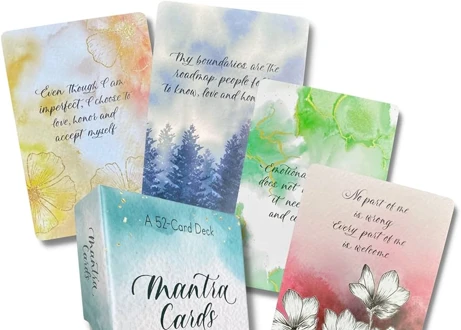Welcome to the mystical world of Tarot rituals, where ancient wisdom meets modern stress relief techniques. If you’re feeling overwhelmed by the chaos of daily life and seeking inner peace, Tarot rituals can serve as a guiding light. In this article, we will explore the power of Tarot, how it can help reduce stress, and provide step-by-step instructions on creating a sacred space, grounding and centering yourself, cleansing and energizing your cards, drawing Tarot cards for guidance, and reflecting through journaling. So, grab your Tarot deck, find a cozy corner, and let’s embark on a journey of self-discovery and tranquility.
Contents
Understanding Tarot
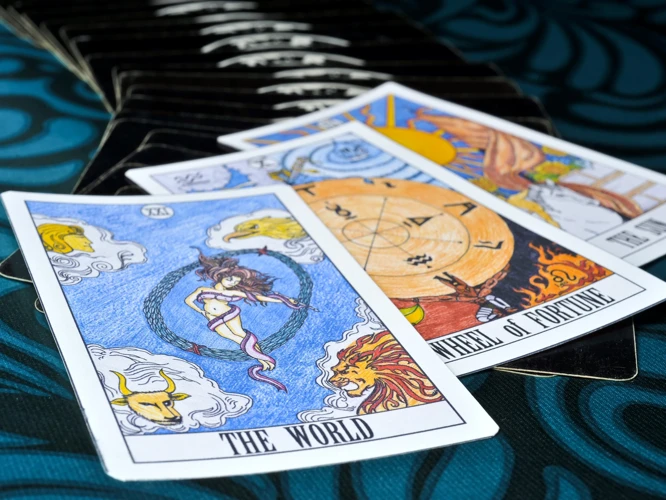
Tarot originated in the 15th century as playing cards, but it has evolved into a powerful tool for divination, self-reflection, and spiritual guidance. A traditional Tarot deck consists of 78 cards, divided into the Major Arcana and the Minor Arcana. The Major Arcana represents major life events and spiritual lessons, while the Minor Arcana reflects everyday situations and emotions. Each card carries symbolic imagery, archetypal figures, and esoteric meanings, making Tarot a rich and multifaceted system.
Tarot can be a valuable resource when it comes to managing stress and finding inner peace. The symbolic imagery of Tarot cards taps into our subconscious mind, allowing us to explore our thoughts, feelings, and fears on a deeper level. By engaging with Tarot, we can gain insight into the root causes of our stress, identify patterns, and discover potential solutions or coping strategies. Tarot also provides a sense of empowerment as we navigate life’s challenges, reminding us that we have the ability to make conscious choices and find our own paths. Additionally, the act of engaging in Tarot rituals and practices can be soothing and meditative, providing a much-needed break from the daily hustle and bustle. Whether we seek guidance on a specific issue or simply want to cultivate a sense of calm, Tarot has the potential to be a transformative tool for stress reduction.
Anchor Text: Tarot Work and Stress
What is Tarot?
Tarot is a mystical practice that uses a deck of cards for divination and spiritual exploration. It originated in the 15th century as playing cards but has evolved into a powerful tool for gaining insight into various aspects of life. A traditional Tarot deck consists of 78 cards, divided into the Major Arcana and the Minor Arcana. The Major Arcana consists of 22 cards, each representing a significant life event or spiritual lesson. These cards often depict archetypal figures and carry deep symbolism. The Minor Arcana consists of 56 cards, divided into four suits: Wands, Cups, Swords, and Pentacles. These cards reflect everyday situations, emotions, and challenges. Each suit has 14 cards, including the Ace to Ten and four Court cards (Page, Knight, Queen, and King). When using Tarot, the reader shuffles the cards and lays them out in various spreads to gain insight into specific questions or areas of life. The interpretation of the cards is subjective and requires an understanding of the card meanings and intuitive abilities. Tarot can be a powerful tool for self-reflection, guidance, and finding inner peace.
Anchor Text: Tarot Cards for Calming Anxiety
How Tarot Can Help with Stress
Tarot can serve as a powerful tool for stress reduction and finding inner peace. Here are a few ways in which Tarot can help:
1. Self-Reflection: Tarot allows us to dive deep into our subconscious mind and explore our thoughts, emotions, and stress triggers. By examining the symbolism and meaning of the cards, we can gain valuable insights into our own patterns, beliefs, and behaviors. This self-awareness is the first step towards managing and reducing stress.
2. Perspective Shift: When we’re caught up in the midst of stress and chaos, it can be difficult to see the bigger picture. Tarot cards provide a fresh perspective and allow us to step outside of our immediate worries. They offer guidance and reminders that there are multiple paths to take and solutions to explore. This shift in perspective can bring a sense of relief and calm.
3. Problem Solving: Many Tarot spreads are designed specifically for problem-solving and decision-making. Whether it’s a simple three-card spread or a more complex spread, Tarot can help us analyze situations, consider different angles, and explore potential outcomes. This process of actively engaging with the cards helps us find clarity and make informed choices, reducing stress caused by uncertainty.
4. Emotional Healing: Stress often manifests as emotional turmoil. Tarot can help us navigate and heal these emotions by providing a safe space for expression and reflection. Each card represents different aspects of human experience, and by connecting with the cards, we can tap into our own emotional landscape. This self-exploration can lead to emotional release, understanding, and ultimately, inner peace.
Anchor Text: Best Tarot Spreads for Stress Relief
Creating a Sacred Space
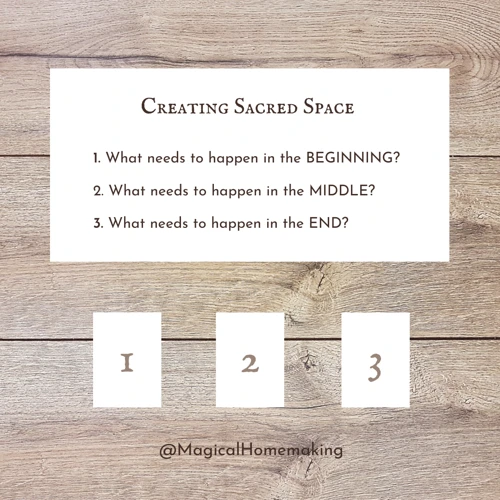
Creating a sacred space is an essential step in preparing for Tarot rituals and finding inner peace. It allows you to establish a dedicated environment where you can connect with your intuition and the divine energies. Here are some key elements to consider when creating your sacred space:
1. Setting the Mood: Begin by setting the mood in your space. You can dim the lights, light candles, and play soft, relaxing music to create a serene atmosphere. Consider using essential oils or incense to add a soothing aroma to the space.
2. Choosing Tarot Decks and Crystals: Select a Tarot deck that resonates with you and your intentions. There are numerous decks available, each with its own unique imagery and symbolism. Additionally, you may choose to incorporate crystals into your space. Crystals have specific energies that can enhance your Tarot practice. For example, amethyst can promote relaxation and clarity, while rose quartz can foster self-love and emotional healing.
3. Arranging Altar or Table: Designate a sacred space by setting up an altar or table. Place your Tarot deck and crystals on the altar, along with any other meaningful objects like statues, trinkets, or personal mementos. Arrange them in a way that feels visually pleasing and spiritually significant to you.
4. Clearing the Space: Before beginning any rituals, it’s essential to cleanse and purify the space. You can do this by smudging with sage or using other clearing techniques like sound vibrations with bells or singing bowls. This helps remove any negative energies and creates a clean slate for your Tarot practice.
5. Personalize and Make it Sacred: Add personal touches to your sacred space to make it truly yours. You may want to incorporate symbols or images that hold significance for you, such as a favorite deity or an affirmation that brings you peace. Remember, your sacred space is meant to be a reflection of your spirituality and a sanctuary for your soul.
By creating a sacred space, you establish a dedicated and harmonious environment for your Tarot rituals. This sacred space becomes a portal where you can enter a state of calm and receptivity, allowing you to tap into your intuition and find inner peace.
Setting the Mood
When it comes to Tarot rituals, setting the mood is essential for creating a sacred and peaceful space. Here are some steps you can take to set the mood for your Tarot practice:
1. Find a Quiet Space: Choose a quiet area where you won’t be easily disturbed. This could be a cozy corner in your home or a serene outdoor spot.
2. Lighting: Dim the lights or use soft, ambient lighting for a calm atmosphere. Consider using candles or fairy lights to create a soothing glow.
3. Incense or Aromatherapy: Burn incense or use essential oils to fill the space with calming scents. Lavender, jasmine, and sandalwood are popular choices for relaxation and spiritual connection.
4. Background Music: Play gentle instrumental music or nature sounds to enhance the ambiance. You can find relaxing playlists or meditation music online.
5. Clear the Clutter: Remove any unnecessary clutter or distractions from your space. A clutter-free environment promotes mental clarity and focus.
6. Sacred Objects: Place meaningful objects, such as crystals, statues, or spiritual symbols, around your space. These items can help to create a sacred energy and enhance your connection with the Tarot.
Remember, creating a serene environment is a personal preference, so feel free to customize these suggestions to suit your individual taste and energy. By setting the mood for your Tarot rituals, you are creating a tranquil space that invites relaxation, introspection, and a deeper connection with your Tarot deck.
Choosing Tarot Decks and Crystals
When it comes to choosing Tarot decks and crystals for your Tarot rituals, trust your intuition and personal preferences. Tarot decks come in a variety of artistic styles, themes, and interpretations, so it’s important to find one that resonates with you. Some popular decks include the Rider-Waite-Smith Tarot, the Thoth Tarot, or even oracle decks that incorporate Tarot-like symbolism. Consider the imagery, symbolism, and energy of the deck when making your selection. If you’re drawn to a particular deck, it’s likely because it speaks to your subconscious on a deeper level.
In addition to choosing a Tarot deck, crystals can enhance the energy and intention you bring to your Tarot rituals. Crystals like Amethyst, Clear Quartz, or Selenite are often favored for their cleansing and purifying properties. They can help amplify the intuition and connection to the Tarot cards. Other crystals like Rose Quartz, Citrine, or Black Tourmaline can be used to promote self-love, abundance, or protection during your Tarot practice. Take some time to explore different crystals, their meanings, and how they resonate with you. You may choose to have crystals nearby while you perform your Tarot readings or meditate with them to enhance the energetic flow.
Remember, the most important aspect of choosing Tarot decks and crystals is to find ones that align with your personal energy and intentions. Allow yourself to be drawn to what feels right for you, and your Tarot rituals will become even more meaningful and powerful.
Grounding and Centering
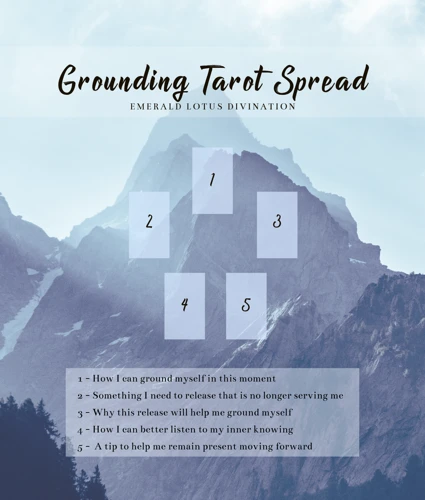
Grounding and centering yourself is an essential step in Tarot rituals. It helps to establish a sense of stability and focus before diving into the world of Tarot. There are various techniques you can employ to ground and center your energy.
One powerful technique is deep breathing exercises. Find a quiet and comfortable space where you can sit or lie down. Close your eyes and take slow, deep breaths. Inhale deeply through your nose, allowing your belly to expand, and then exhale slowly through your mouth, releasing any tension or stress. As you breathe, imagine roots growing from the soles of your feet, deep into the earth, grounding you and connecting you to its stability and nurturing energy. Repeat this deep breathing exercise for a few minutes until you feel centered and calm.
Another way to ground and center yourself is through guided meditation with Tarot. Choose a Tarot card that resonates with you or represents the energy you wish to cultivate. Sit in a comfortable position and hold the card in your hands. Close your eyes and visualize yourself stepping into the card, immersing yourself in its energy. Allow the card to guide you through a mental journey, exploring its symbolism and messages. This meditation not only grounds and centers you but also deepens your connection with the Tarot deck.
Remember, grounding and centering is a personal practice, and what works for one person may not work for another. Experiment with different techniques and find what resonates with you. By grounding and centering yourself, you create a solid foundation for your Tarot rituals, enabling a more focused and meaningful experience.
Anchor Text: Tarot Cards for Calming Anxiety
Deep Breathing Exercises
Deep breathing exercises are an essential component of grounding and centering oneself during a Tarot ritual. These exercises help calm the mind, relax the body, and connect with the present moment. To begin, find a comfortable position, either sitting or lying down. Close your eyes and take a deep breath in through your nose, allowing your belly to expand. Hold the breath for a moment, and then exhale slowly through your mouth, releasing any tension or stress. Repeat this process several times, focusing on the sensation of the breath entering and leaving your body. As you breathe, visualize any stress or negative energy leaving your body with each exhale, and imagine a sense of calm and peace flowing in with each inhale. Feel your body becoming more relaxed and grounded with each breath. Deep breathing exercises can be especially beneficial before drawing Tarot cards, as they help create a clear and focused state of mind, allowing for a more meaningful and intuitive card reading experience. So take a few moments to practice deep breathing and prepare yourself for a harmonious Tarot ritual.
Anchor Text: Deep Breathing Exercises
Guided Meditation with Tarot
Guided meditation with Tarot combines the power of visualization and Tarot symbolism to deepen our connection with ourselves and the cards. Here are some steps to incorporate guided meditation into your Tarot practice:
1. Choose a quiet and comfortable space where you can relax without distractions. It could be a peaceful corner of your home or even outdoors in nature.
2. Select a Tarot card that resonates with your current state of mind or the specific theme you wish to explore during the meditation. Place the card in front of you, facing up.
3. Sit in a comfortable position with your spine straight and close your eyes. Take a few deep breaths to center yourself and relax.
4. Visualize yourself stepping into the imagery of the Tarot card. Imagine yourself surrounded by the colors, symbols, and characters present in the card. Let your imagination come alive as you enter this mystical world.
5. Engage your senses and explore the details of the card. Notice the textures, smells, sounds, and tastes that the card evokes. Allow yourself to fully immerse in the experience.
6. As you continue to visualize, pay attention to any emotions, thoughts, or insights that arise. Trust your intuition and let the card’s message unfold within you.
7. While in this meditative state, you can also ask the card specific questions or seek guidance on a particular situation. Trust that the answers will come to you either during the meditation or in the following days.
8. When you are ready to conclude the meditation, slowly bring your awareness back to the present moment. Take a few deep breaths, wiggle your fingers and toes, and open your eyes.
Remember, there is no right or wrong way to experience guided meditation with Tarot. Each session is a personal journey of self-discovery and connection. Allow yourself to be open to the messages that arise and embrace the serenity that comes with this practice.
Anchor Text: Guided Meditation and Tarot
Cleansing and Energizing the Cards
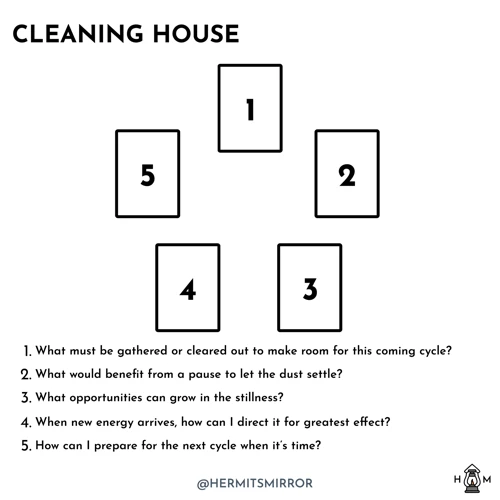
Cleansing and energizing your Tarot cards is an essential step in maintaining their clarity and vibrational energy. There are several methods you can use to cleanse and revitalize your deck:
1. Smudging with sage: Light a bundle of sage or sage incense and pass the cards through the smoke, focusing on releasing any stagnant or negative energies. Visualize the smoke purifying the cards, making them a clear channel for intuitive guidance.
2. Using crystals: Place a crystal with cleansing properties, such as clear quartz or selenite, on top of your Tarot deck overnight. The crystal will absorb any negative energy and restore the cards’ energetic balance.
3. Sound vibrations: Use sound as a cleansing tool by ringing a bell or a singing bowl over your Tarot deck. The sound waves help to disperse any stagnant energy and bring a renewed sense of vibrancy to the cards.
4. Moonlight or sunlight: Leave your Tarot cards under the moonlight or sunlight for a few hours to recharge their energy. The gentle light from the moon or the sun will infuse the cards with positive energy and enhance their intuitive abilities.
Remember to set your intention while performing these cleansing rituals. Visualize any unwanted energy leaving the cards and invite in fresh, positive energy. Regularly cleansing and energizing your Tarot cards will ensure that they remain clear, attuned, and ready to provide accurate guidance.
Anchor Text: Tarot Cards for Calming Anxiety
Smudging with Sage
Smudging with sage is a sacred practice rooted in ancient traditions. This ritual involves burning dried sage leaves, often bundled together as a “smudge stick,” to purify and cleanse the energy of a space or an object, including your Tarot cards. Here are the steps to perform smudging with sage for card cleansing:
1. Prepare your materials: Gather a smudge stick (preferably white sage), a heatproof bowl or shell, and a lighter or matches.
2. Set your intention: Before you begin, take a moment to set your intention for the smudging ritual. You may want to visualize the smoke carrying away any negative or stagnant energy from your Tarot cards, leaving them cleansed and energetically refreshed.
3. Open windows or doors: It is beneficial to have some airflow while smudging. Open a window or door to allow the smoke to carry away any released energy.
4. Light the smudge stick: Use the lighter or matches to ignite the tip of the smudge stick. Let it catch fire, then gently blow out the flame, allowing the sage to smolder and release smoke.
5. Begin smudging: Hold your Tarot cards in one hand and the smudge stick in your other hand. Start at one end of the cards and move the smudge stick in a circular or sweeping motion, allowing the smoke to surround and pass over each card. Be sure to cover both sides of the cards.
6. Focus on intention: As you move the smudge stick, keep your intention in mind. Imagine the smoke absorbing any negative or stagnant energy, leaving your Tarot cards cleansed and ready for use.
7. Smudge the entire deck: After smudging each card individually, fan the smoke from the smudge stick over the entire deck to ensure thorough cleansing.
8. Extinguish the smudge stick: Once you have finished smudging, gently press the smudge stick into the heatproof bowl or shell to extinguish it. Be sure it is fully extinguished before leaving it unattended.
Remember, smudging with sage is a personal ritual, and you can adapt it to suit your preferences. Some people like to smudge their space before and after performing Tarot readings as well. Experiment with different methods and find what feels most meaningful and effective for you.
Anchor Text: Smudging
Using Crystals for Card Cleansing
Using crystals for card cleansing is a popular practice among Tarot enthusiasts. Crystals have unique energetic properties that can help clear any stagnant or negative energy from your Tarot cards. One commonly used crystal for card cleansing is Clear Quartz. Known as the “master healer,” Clear Quartz has the ability to amplify energy and purify surroundings. To use Clear Quartz for card cleansing, you can simply place the crystal on top of your Tarot deck overnight or for a few hours. As the Clear Quartz absorbs any negative energy, it will help restore the cards’ vibrancy and clarity.
Another crystal option for card cleansing is Selenite. Selenite is highly regarded for its cleansing and purifying properties. Its gentle yet potent energy can help remove any energetic residue from the cards. To cleanse your Tarot deck with Selenite, you can create a small Selenite grid by placing several Selenite crystals around your Tarot deck. Leave the crystals in place for a few hours or overnight, allowing them to work their cleansing magic.
Amethyst is another crystal that can be used for card cleansing. This purplish gemstone is known for its calming and protective properties. Holding an Amethyst crystal in your hand while shuffling the cards can help infuse them with positive and soothing energy. You can also place the Amethyst crystal on top of your Tarot deck for a few minutes before starting a reading, allowing it to cleanse and clear any unwanted energies.
Remember to intuitively choose the crystal that resonates with you and your intentions. Before and after using the crystals for card cleansing, you can also cleanse the crystals themselves using smudging or other cleansing methods to ensure their energy remains pure and potent.
Anchor Text: Tarot Cards for Calming Anxiety
Drawing Tarot Cards
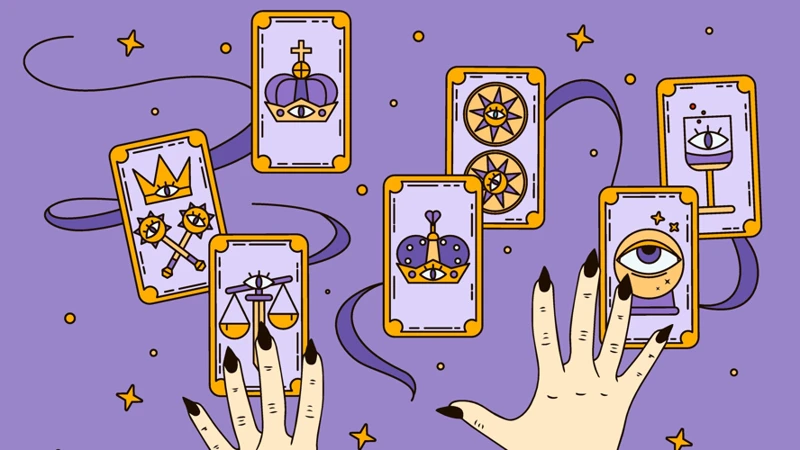
Drawing Tarot cards is a fundamental practice in Tarot rituals that allows us to tap into the wisdom and guidance of the Tarot deck. There are various methods you can use to draw cards, depending on your intention and the type of insight you’re seeking.
One common method is the Single Card Daily Guidance. This involves drawing a single card each day to receive guidance and insight for the day ahead. Begin by quieting your mind and focusing on your intention. Shuffle the deck while contemplating your question or the area of your life you want guidance on. Once you feel ready, draw one card from the deck and examine its imagery and symbolism. Reflect on how it relates to your question or situation, and consider its messages and lessons for the day.
Another popular method is the Three-Card Spread for Insight. This spread allows for a more comprehensive exploration of a situation or question. Shuffle the deck and focus on your intention. Then, draw three cards and place them face down in a row. Flip the first card and interpret its meaning in relation to the past or the root cause of the situation. Flip the second card to understand the present circumstances or current challenges. Finally, flip the third card to gain insights into the future or potential outcomes of the situation. By examining the connections between the cards, you can gain a deeper understanding of the situation at hand.
Remember, drawing Tarot cards is a personal and intuitive process. Trust your intuition and allow the cards to speak to you. Whether you choose a single card or a more complex spread, drawing Tarot cards can provide valuable insights and guidance on your journey toward reducing stress and finding inner peace.
Anchor Text: Best Tarot Spreads for Stress Relief
Single Card Daily Guidance
When it comes to finding daily guidance and insights, a single card Tarot draw can be a powerful practice. This ritual involves shuffling your Tarot deck while focusing on a specific question or intention. Once you feel ready, you can choose a single card from the deck, which will serve as your daily guidance.
Each card in the Tarot deck carries its own unique symbolism and meaning. When drawing a card for daily guidance, pay attention to the imagery, colors, and symbols on the chosen card. These elements will provide you with clues and messages that can help you navigate your day with clarity and purpose.
Analyzing the card is a personal and intuitive process. Take note of the emotions that arise when you look at the card, as well as any thoughts or insights that come to mind. Consider how the card’s meaning relates to your current situation or question.
Using a journal can be helpful for recording your insights and reflect on them later. Write down the card you pulled, describe the imagery, and note any intuitive messages or thoughts that come up. Journaling allows you to deepen your connection with the card’s meaning and establish patterns over time. You may find that certain cards consistently appear in your daily draws, indicating recurring themes or areas of focus in your life.
Remember, the purpose of the single card daily guidance is not to predict the future, but rather to gain insights and inspiration for the day ahead. This practice can help you approach your day with mindfulness and intention, allowing you to make conscious choices and navigate any challenges or opportunities that come your way.
Anchor Text: Best Tarot Spreads for Stress Relief
Three-Card Spread for Insight
The Three-Card Spread is a popular method in Tarot readings for gaining insight into a specific situation or question. It provides a concise yet comprehensive view of past influences, current circumstances, and potential outcomes. Here’s how to perform a Three-Card Spread for insight:
1. Shuffle and Focus: Begin by shuffling the Tarot deck while concentrating on your question or the area of your life you wish to explore. Take a moment to ground yourself and clear your mind.
2. Draw the Cards: Once you feel connected to the energies of the deck, draw three cards from the deck and place them face down in a row.
3. Turn Over the First Card: Start with the card on the left and turn it over. This card represents the past influences or events that have led you to the current situation. Pay attention to the symbolism, colors, and overall message of the card.
4. Turn Over the Second Card: Move on to the middle card and reveal it. This card represents the present circumstances or challenges you are currently facing. Reflect on how it relates to your question or situation and what it may be trying to convey.
5. Turn Over the Third Card: Finally, turn over the card on the right. This card represents the potential future outcomes or possibilities based on your current path. Consider the insights and guidance this card offers as you contemplate your next steps.
6. Interpret the Spread: Once all three cards are revealed, take a moment to interpret their collective message. Look for connections, patterns, and themes that emerge. Consider how the past influences have shaped the present and how the potential outcomes may be influenced by your current choices. Trust your intuition and take note of any feelings or thoughts that arise during the interpretation.
Remember, the Three-Card Spread is a versatile tool that can be adapted to various situations or questions. Feel free to modify it as needed to suit your needs and preferences.
Anchor Text: Best Tarot Spreads for Stress Relief
Reflecting and Journaling
Reflecting and journaling are essential components of a Tarot practice that can greatly enhance your self-discovery and inner peace. When we engage with Tarot cards, we receive messages and insights from our subconscious mind. Taking the time to reflect on these messages and record them in a journal allows us to deepen our understanding and foster self-awareness. Here are two ways you can incorporate reflecting and journaling into your Tarot rituals:
1. Exploring Card Meanings: After drawing a card or completing a Tarot spread, take a moment to reflect on its symbolism, archetypes, and overall message. Consider how it relates to your current situation or question. What emotions does it evoke? What lessons or guidance can you glean from it? Write down your thoughts and interpretations in your journal. This process of analyzing and reflecting on the cards can help you gain new perspectives and unravel hidden truths.
2. Writing Prompts for Self-Reflection: To deepen your Tarot practice and facilitate personal growth, use writing prompts as a way to delve deeper into the messages and insights received from the cards. These prompts can be specific to the cards you drew or more general self-reflection questions. For example, you can ask yourself, “How does this card relate to my current challenges?” or “What actions can I take to implement the lessons this card is teaching me?” Allow yourself to write freely and intuitively, without judgment or expectations. This practice encourages introspection and can uncover valuable insights about yourself, your desires, and your path towards inner peace.
Remember, reflecting and journaling provide an opportunity to develop a deeper connection with the Tarot and yourself. It is a personal exploration that allows you to uncover patterns, track your progress, and gain clarity on your journey towards reducing stress and finding inner peace.
Anchor Text: Best Tarot Spreads for Stress Relief
Exploring Card Meanings
When exploring the meanings of Tarot cards, it’s important to approach them with an open mind and a willingness to delve into their symbolism. Each card in the Tarot deck has its own unique interpretation and message. To begin, start by looking closely at the imagery depicted on the card. Notice the colors, symbols, figures, and any other details that catch your attention. These visual elements can provide clues to the card’s meaning.
Next, consider the numerical associations of the card. In the Major Arcana, each card is numbered, from The Fool (0) to The World (21). The number can add depth and context to the card’s interpretation. For example, the number 2 often signifies balance, cooperation, or choices, while the number 9 may represent completion, culmination, or spiritual growth.
Additionally, pay attention to the suits in the Minor Arcana. These suits, typically Cups, Wands, Swords, and Pentacles, represent different aspects of life, such as emotions, creativity, intellect, and material matters, respectively. Each suit has its own set of characteristics and themes that contribute to the overall meaning of the card.
As you explore the meanings of Tarot cards, remember that personal intuition plays a vital role. Trust your instincts and allow your own interpretations to come through. While there are traditional interpretations of each card, your individual experiences and perspectives can add depth and nuance to the messages conveyed by the cards. Journaling about your observations and insights can be a helpful way to deepen your understanding of the cards and develop your own unique connections with them.
Anchor Text: Tarot Cards for Calming Anxiety
Writing Prompts for Self-Reflection
Writing Prompts for Self-Reflection can enhance your Tarot practice and deepen your understanding of the cards’ meanings. Here are a few prompts to get you started:
1. The card I drew today reflects my current state of mind because…
2. How does the imagery on this card resonate with my emotions or experiences?
3. What lessons can I learn from the symbols and archetypes present in this card?
4. Are there any patterns or recurring themes in the cards I have drawn recently? If so, what do they signify?
5. How can I apply the message of this card to a specific situation or challenge in my life right now?
6. What does this card reveal about my strengths or weaknesses?
7. Are there any insights or messages from this card that I may have overlooked at first glance?
8. How can I incorporate the energy or qualities of this card into my daily life for personal growth?
9. What emotions or reactions does this card evoke in me, and why?
10. How do I relate to the characters or figures depicted on this card, and what do they represent in my life?
Remember, there are no right or wrong answers when it comes to self-reflection with Tarot. Allow yourself to be open and vulnerable, and trust your intuition as you explore these prompts. Writing down your thoughts and feelings can provide a valuable record of your journey and serve as a source of inspiration for future introspection.
Anchor Text: Best Tarot Spreads for Stress Relief
Conclusion
In conclusion, Tarot rituals can be a powerful tool for reducing stress and finding inner peace. Through the ancient art of Tarot, we can tap into our subconscious mind, gain insight into our emotions and life situations, and find guidance on our spiritual journey. Creating a sacred space, grounding and centering ourselves, and cleansing and energizing our Tarot cards are all important steps in setting the stage for a transformative experience. Drawing Tarot cards and reflecting on their meanings through journaling provide us with valuable insights and self-reflection. The act of engaging with Tarot in a mindful and intentional way can bring us a sense of tranquility and empowerment. So, embrace the wisdom of the Tarot, and let its magic guide you towards stress reduction and inner harmony.
Remember, Tarot is not a substitute for professional help or medical advice. If you are experiencing severe stress or mental health issues, it is important to seek the support of a qualified professional.
Frequently Asked Questions
FAQs about Tarot Rituals for Reducing Stress and Finding Inner Peace
1. What is the best time to perform Tarot rituals for stress relief?
The best time to perform Tarot rituals is when you have a quiet and uninterrupted space, where you can fully focus on the cards and your inner self.
2. Can Tarot rituals help with anxiety and panic attacks?
Tarot rituals can be a helpful tool in managing anxiety and panic attacks. They can provide guidance, support, and a sense of clarity during challenging moments.
3. Do I need to be an experienced Tarot reader to benefit from these rituals?
No, you don’t need to be an experienced Tarot reader. These rituals are designed for anyone interested in using Tarot as a tool for reducing stress and finding inner peace.
4. How often should I cleanse and energize my Tarot cards?
It’s recommended to cleanse and energize your Tarot cards regularly, especially if you use them frequently. This ensures that you maintain a clear and positive connection with the cards.
5. Can I use any Tarot deck for these rituals?
Yes, you can use any Tarot deck that resonates with you. Choose a deck with artwork and symbolism that speaks to your intuition and personal style.
6. How can crystals enhance my Tarot rituals?
Crystals can enhance your Tarot rituals by providing energetic support and amplifying your intentions. Each crystal has its unique properties that can complement the energy of the cards.
7. Can I perform Tarot rituals without a sacred space?
While having a sacred space can enhance your Tarot rituals, it is not mandatory. You can create a temporary sacred space wherever you feel comfortable and free from distractions.
8. What if I don’t understand the meaning of a Tarot card?
If you’re unsure about the meaning of a card, consult a Tarot guidebook or reputable online resources. Trust your intuition and personal interpretation of the card’s symbolism.
9. How long should I meditate with a Tarot card?
The duration of your meditation with a Tarot card depends on your personal preference. Start with a few minutes and gradually increase the time as you become more comfortable.
10. Can I perform Tarot rituals for someone else’s stress relief?
Yes, you can perform Tarot rituals for someone else’s stress relief with their permission. Focus on their specific concerns or ask them to provide a question or area of focus to guide the reading.
